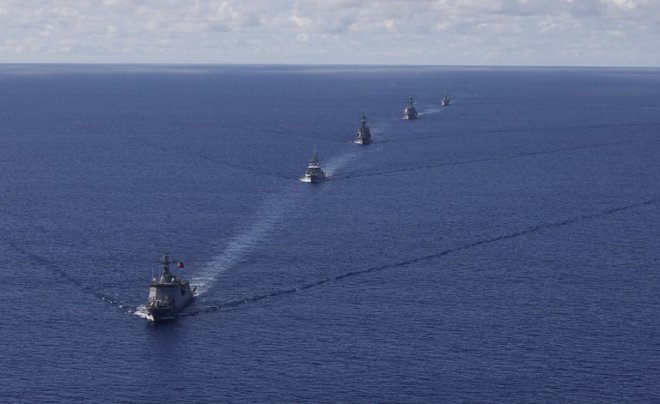China stages naval drills during Philippines-US exercise
China conducted a multiple-day naval exercise in the South China Sea as the Philippines held major drills with the United States and other allied nations.A number of warships and helicopters from the Southern Theater Command of the People’s Liberation Army (PLA) Navy conducted “coordinated offensive and defensive combat drills” in different sea areas, said a press release posted on the Navy’s WeChat account.
The South China Sea is PLA Southern Theater Command"s primary area of responsibility.
According to the release, at least two large guided missile destroyers – the Type 055 Yan’an (106) and the Type 052D Hefei (174) – as well as a submarine and a Z-9 anti-submarine helicopter, took part in the exercise that lasted several days.
A major part of the exercise focused on anti-submarine warfare, it said.
In one of the scenarios, an anti-submarine helicopter was deployed for reconnaissance in tandem with the destroyers’ sonar systems. The flotilla was then switched to a tactical assault formation when a suspected enemy submarine was detected.
The press release did not specify when the drills took place but the state-aligned mouthpiece Global Times, normally well-informed about the PLA’s activities, said they happened “at a time when the U.S. and the Philippines are holding the 12-day multilateral exercise, Samasama,” in the waters off Luzon island.
“Since August, the Philippines has been provoking China by sending vessels to trespass into waters near Chinese islands and reefs in the South China Sea and hyping up Chinese interceptions,” the hawkish newspaper said.
 Warships from the U.S., the Philippines, the United Kingdom, Japan and Canada participate in Samasama over the weekend in the Philippine Sea. Credit: U.S. Pacific Fleet
Warships from the U.S., the Philippines, the United Kingdom, Japan and Canada participate in Samasama over the weekend in the Philippine Sea. Credit: U.S. Pacific FleetSome 1,800 troops and six warships from the U.S., Japan, Great Britain and Canada are taking part in Exercise Samasama (Together in Tagalog), which includes land phases as well as anti-submarine warfare, search and rescue operations and air defense drills.
The multilateral exercise is aimed at boosting military cooperation between the Philippines, the United States and like-minded nations amid China’s increased assertiveness.
Joint activities
Beijing and Manila have been at loggerheads over some reefs claimed by both in the South China Sea.
The Philippines accuses China of blocking its access to Scarborough Shoal and Second Thomas Shoal while China says Manila seeks to “stir up troubles.”
The Philippine government has been discussing joint activities with foreign countries besides the U.S., especially U.S. treaty allies Japan and Australia.
 Multinational troops taking part in Samasama 2023. Credit: U.S. Pacific Fleet
Multinational troops taking part in Samasama 2023. Credit: U.S. Pacific FleetIn their first ever quadrilateral defense chief talks in June, the U.S., Japan, Australia and the Philippines agreed on a number of cooperation initiatives including joint four-party maritime patrols in the South China Sea in the near future.
Manila and Canberra recently signed a Strategic Partnership Agreement, and are discussing “a joint sail” in the South China Sea, according to Australian Foreign Minister Penny Wong.
The joint patrol will be taking place “in an appropriate maritime location as yet to be announced,” Wong said during a joint press conference with her Philippine counterpart Enrique Manalo in Adelaide on Oct. 10.
The two militaries staged a large-scale anti-invasion exercise in August in Palawan, where they are to conduct another smaller exercise called Dawn Caracha 2023 in late October with focus on counterterrorism and special operations.
“Anything that can strengthen Australia-Philippines ties in the face of increasing Chinese provocations in the South China Sea is a good thing,” said Malcolm Davis, a senior analyst at the Australian Strategic Policy Institute (ASPI).
“The Philippines is fast emerging as a key partner for Australia in ASEAN, a very big change from the Duterte years,” Davis told Radio Free Asia.
“The same goes for the U.S.-Philippines relationship, so there"s an important integrated deterrence dimension here, which these closer relations underpin,” he added.
In February, the Marcos administration granted permission to the U.S. military to use four additional locations as operational ground in the Philippines, bringing the number of locations now accessible to U.S. troops to nine.
Manila has already visiting force agreements with Washington and Canberra and is looking to conclude the third with Japan. This would facilitate having Japanese Self-Defense Forces enter the Philippines for exercises and training.
Edited by Mike Firn and Elaine Chan.
[圖擷取自網路,如有疑問請私訊]
|
本篇 |
不想錯過? 請追蹤FB專頁! |
| 喜歡這篇嗎?快分享吧! |
相關文章
AsianNewsCast






















